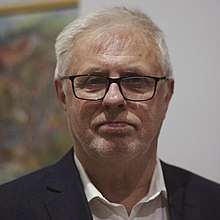Eugeniusz Knapik
Eugeniusz Knapik (born July 9, 1951 in Ruda Śląska) is a Polish pianist and composer of classical music best known for his 1980 chamber piece String Quartet No. 1.[1] Knapik studied composition and piano with Henryk Górecki (1933–2010) [2][3] and Czesław Stańczyk at the University of Music in Katowice. Later, he studied composition under Olivier Messiaen in Paris[4] under a French government scholarship. As a pianist he has recorded widely, specialising mainly in 20th-century music. He has won numerous prizes for his compositions, including at the Festival of Polish Piano Interpretation in Słupsk, and the International Chamber Music Competition in Vienna.[5]

Along with Andrzej Krzanowski and Aleksander Lasoń, Knapik is generally seen as a leading member of the composers who emerged in Poland during the mid-1970s. This group was collectively named Stalowa Wola after the city at which they stated their manifesto at a 1975 festival of music which was sub-titled "From young composers to a young City". Their statement read, "The work of the composers who entered their artistic lives at the festivals in Stalowa Wola was a kind of opposition to the 1950s and 60s avant-garde: opposition towards novelty for novelty's sake, and towards total destruction. This opposition was a spontaneous, intuitive, deep-rooted reaction, which we only later became fully aware of."[5]
Knapik is often seem as a composer out of his time, in that his music is heavily influenced by the musical idioms of the late Romantic era, in particular by the work of Gustav Mahler (1860-1911). More recent influences include Górecki, Krzysztof Penderecki (b. 1933) and Witold Lutosławski (1913-1994).[6] He has borrowed from 19th and 20th century English language poetry for both libretto and inspiration, a fact which sets him apart from most of his Polish contemporaries.[7]
Today, Knapik teaches at the Katowice Academy of Music, where he is professor and director of composition.[8]
Selected works
- Sonata for Violin and Piano, 1971
- Psalms for soloists, choir and orchestra, 1973–75
- String Quartet No. 1, 1980
- Hymn for clarinet, trombone, cello and piano, 1980
- The Minds of Helena Troubleyn, Cycle of three Operas, 1987-96[7]
- Up into the Silence for soprano, baritone, string quartet and orchestra, 1996-2000
- Introduction to Mystery for Tenor, Mixed Choir and Symphony Orchestra, 2005
- La Liberta chiama la liberta, opera, 3rd Part of the Trilogy The Minds of Helena Troubleyn, 2010
Notes
- "String Quartet No. 1". Allmusic. Retrieved on June 1, 2009.
- Significantly at the point when Górecki was moving from modal to melodic composition
- Thomas, 290
- "Eugeniusz Knapik Archived 2007-12-26 at the Wayback Machine". Adam Mickiewicz Institute. Retrieved on June 1, 2009.
- "Eugeniusz Knapik". Polskie Centrum Informacji Muzycznej. Retrieved on June 1, 2009.
- Thomas, 292
- Thomas, 292
- "Eugeniusz Knapik". Warsaw Autumn Festival, 2003. Retrieved on June 1, 2009.
References
- Thomas, Adrian. "Polish Music since Szymanowski". In: Music in the Twentieth Century. Cambridge and New York: Cambridge University Press, 2005. ISBN 0-521-58284-9